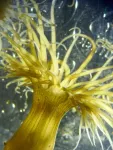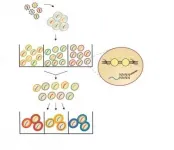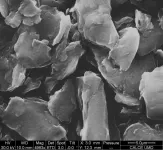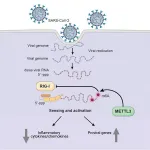Corals that "spit" algae
An ancient immune response regulates the development of beneficial symbioses
2021-04-29
(Press-News.org) Microalgae of the dinoflagellate group are known for their ability to survive in other animal cells. These tiny single-cell organisms have engaged in mutually beneficial relationships with corals since primeval times. By passing on critical nutrients to their hosts, dinoflagellates allow corals to thrive even in barren areas. A research team from the Centre for Organismal Studies (COS) of Heidelberg University recently discovered that such symbioses within the cell essentially depend on the ability of the algae to suppress the immune system of their host cell and thereby avoid being "spit out" again. At the same time, the researchers found indications that this cellular immune response is an evolutionarily ancient immune mechanism that is more widespread than previously assumed.
This mechanism is known as vomocytosis. Contrary to previous assumptions, microalgae ingested by corals are not digested by the cell if they prove unsuitable as symbionts - that is, partners in a symbiotic relationship. Instead, they are "spit out" again in the process of vomocytosis. Special dinoflagellates are able to specifically suppress this immune response of their host cells in order to remain in the cell. A study led by cell biologist Prof. Dr Annika Guse at the COS demonstrated how they are able to do that. "The challenge for the corals is to differentiate between beneficial and potentially harmful microorganisms. For their part, the algae have to circumvent the immune response of the host cell, establish an intracellular niche where they can survive, and coordinate their own cell functions with those of their host to efficiently exchange nutrients," explains the researcher.
Until now, there has been no experimental evidence that could explain any of the conventional theories. Using the model system Exaiptasia diaphana (Aiptasia) of the sea anemone species, Prof. Guse's team recently uncovered how immune suppression by the symbionts helps the host cell to recognise suitable microalgae and tolerate them for the long term. The Aiptasia anemone larvae ingest the symbionts from the environment in the same way as coral larvae. Furthermore, their size and transparency make the larvae of this sea anemone perfect for high-resolution imaging and cellular experiments.
Aiptasia continually ingests various particles from the environment without differentiating between suitable and unsuitable particles or organisms. Incompatible particles are "spit out" again after a certain amount of time. Symbionts avoid this process of vomocytosis, presumably by disrupting the signal pathways of the toll-like receptors (TLRs) of the host cell. These receptors play a critical role in activating the cell's own immune system and ensure that unwelcome intruders are detected and removed. In most animals, the toll-like receptors are controlled by the MyD88 gene. "We were able to prove that the algae symbionts suppress MyD88 and thus initiate symbiosis. That is how they elude vomocytosis," explains Prof. Guse.
At the same time, the findings of the Heidelberg researchers indicate that vomocytosis involves a mechanism that is more widespread than assumed. Until now, it was believed that the expulsion of harmful intruders was self-initiated to evade the in part highly specialised immune responses of the potential host cell. The study of the Aiptasia model, however, suggests that this process can also be triggered by the host cell. The researchers therefore assume that vomocytosis is an evolutionarily ancient immune mechanism that corals or cnidarians like Aiptasia use to select appropriate symbionts. Prof. Guse: "This suggests that vomocytosis is an important process that led in the first place to the emergence of the intracellular lifestyle of the coral symbionts."
INFORMATION:
The results of the study were published in the journal Nature Microbiology. Funding was provided inter alia through the Horizon 2020 programme of the European Union and by the German Research Foundation.
[Attachments] See images for this press release:

ELSE PRESS RELEASES FROM THIS DATE:
2021-04-29
Nearly half of adults in the United States have hypertension, a condition that raises the risk for heart disease and stroke, which are leading causes of death in the U. S.
At Baylor College of Medicine, Dr. David J. Durgan and his colleagues are dedicated to better understand hypertension, in particular the emerging evidence suggesting that disruption of the gut microbiota, known as gut dysbiosis, can have adverse effects on blood pressure.
"Previous studies from our lab have shown that the composition of the gut microbiota in animal models of hypertension, such as the SHRSP (spontaneously hypertensive stroke-prone ...
2021-04-29
The outbreak of COVID-19 has revealed the widespread effects a pandemic can have on all spheres of life from health, to social life, to the economy. The main thrust of efforts to control the spread has been to decrease the reproduction rate to flatten the curve of the total number of infected individuals per day in order to reduce overload on the health system. The most widely implemented response to the exponential growth of the infection has been widespread quarantine and lockdown. While isolation is an effective tool to decelerate the spread, repeatedly imposing complete ...
2021-04-29
Small and medium-sized manufacturing enterprises (SMEs) face many obstacles and difficulties (economic, technical, cultural, etc.) when it comes to implementing Industry 4.0. "These are transition processes that are economically costly, and in which SMEs often come up against technical and cultural problems, as they are not cognizant of how to make this transition, or of the benefits their companies stand to gain by implementing Industry 4.0," explained the UPV/EHU pre-doctoral researcher Víctor Ramírez-Durán.
While several pieces of work address the incorporating ...
2021-04-29
NEW YORK, NY (April 29, 2021) - In a new resource for the scientific community, published today in Nature Biotechnology, researchers in the lab of Neville Sanjana, PhD, at the New York Genome Center (NYGC) and New York University (NYU) developed CRISPR-sciATAC, a novel integrative genetic screening platform that jointly captures CRISPR gene perturbations and single-cell chromatin accessibility genome-wide. With this technology, they profile changes in genome organization and create a large-scale atlas of how loss of individual chromatin-altering enzymes impacts the human genome. The new method harnesses the programmability of the gene editing system CRISPR to knock-out ...
2021-04-29
Exploring extreme environments can put significant operational challenges on the engineering systems we depend upon to safely explore and at times operate within.
Within high-value and safety-critical applications, such as space exploration or sub-surface drilling, the extreme and at times dynamic operating conditions within the environment, can make it challenging to understand the life expectancy of critical components and sub-systems. Hence, it's a highly complex and at times impossible situation to accurate understand therefore predict.
To have safe, resilient and economically viable operations within these challenge environments, it is vital ...
2021-04-29
Researchers at University of California San Diego School of Medicine have discovered one way in which SARS-CoV-2, the coronavirus that causes COVID-19, hijacks human cell machinery to blunt the immune response, allowing it to establish infection, replicate and cause disease.
In short, the virus' genome gets tagged with a special marker by a human enzyme that tells the immune system to stand down, while at the same time ramping up production of the surface proteins that SARS-CoV-2 uses as a "doorknob" to enter cells.
The study, published April ...
2021-04-29
The burden of student loans in the U.S. continues to grow unabatedly, currently accounting for a total of $1.7 trillion in household debt among nearly 45 million borrowers. "The introduction of income-based repayment over the past decade has made student loans rather complicated products," Paolo Guasoni of Dublin City University said. As borrowers navigate this complex process, they face long-term consequences; people with student debt are less likely to own homes or become entrepreneurs, and generally postpone their enrollment in graduate or professional studies. Though legislative reform is necessary to combat this problem on a grand scale, individual borrowers can take steps to ...
2021-04-29
Hydrogen as a clean, renewable alternative to fossil fuels is part of a sustainable-energy future, and very much already here. However, lingering concerns about flammability have limited widespread use of hydrogen as a power source for electric vehicles. Previous advances have minimized the risk, but new research from the University of Georgia now puts that risk in the rearview mirror.
Hydrogen vehicles can refuel much more quickly and go farther without refueling than today's electric vehicles, which use battery power. But one of the final hurdles to hydrogen power is securing a safe method for detecting hydrogen leaks.
A new study published in Nature Communications documents an inexpensive, spark-free, optical-based hydrogen sensor that is more sensitive ...
2021-04-29
Study Take-Aways
Unprecedented novel discoveries have implications for characterizing biodiversity for all life, conservation, and human health and disease.
o This finding provides novel avenues of research to increase immune defenses, particularly relevant for emerging infectious diseases, such as the current COVID-19 pandemic.
The flagship paper presented whole genome sequence analyses of 16 vertebrate species to illustrate high quality, near error free, near complete, low cost reference genome assemblies.
o Though near 400 species have been sequenced at some level, the quality today reflects ...
2021-04-29
Alzheimer's disease is characterized by the abnormal accumulation and spread of the tau protein in the brain. An international study can now show how tau spreads according to four distinct patterns that lead to different symptoms with different prognoses of the affected individuals. The study was published in Nature Medicine.
"In contrast to how we have so far interpreted the spread of tau in the brain, these findings indicate that tau pathology in the brain varies according to at least four distinct patterns. This would suggest that Alzheimer's is an even more heterogeneous disease than previously thought. We now have reason to reevaluate the concept of typical Alzheimer's, and in the long ...
LAST 30 PRESS RELEASES:
[Press-News.org] Corals that "spit" algae
An ancient immune response regulates the development of beneficial symbioses





